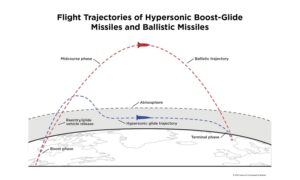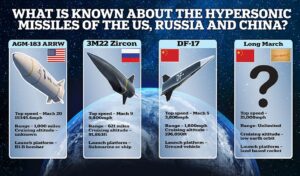
Pic Courtesy: France 24
Emerging class of missile technologies include manoeuvrable vehicles that carry warheads through the atmosphere at more than five times the speed of sound. Hypersonic glide vehicles (HGVs), like all weapons delivered by medium and longer range rocket boosters, can travel at speeds of at least Mach 5, or about 1 mile per second. The key difference between missiles armed with HGVs and missiles armed with ballistic re-entry vehicles (i.e., those that travel on a ballistic trajectory throughout their flight) is not their speed, but their ability to manoeuvre and change course after they are released from their rocket boosters. Hypersonic weapons can be classified into two distinct categories:
- Hypersonic cruise missiles. These operate much like typical sub-sonic and supersonic cruise missiles (using air-breathing engines to power themselves through the atmosphere) but fly at higher speeds. They cannot match the speeds or ranges achievable by boost-glide vehicles.

Pic Courtesy: PTs IAS Academy
- Hypersonic boost-glide Vehicles. They are accelerated to extremely high velocities on rocket boosters similar to those used to launch ballistic missiles. They then proceed to glide, unpowered, through the upper atmosphere until reaching their target.

Pic Courtesy: Union of Concerned scientists
The flight of hypersonic boost-glide vehicle is divided into six stages: boost, ballistic, re-entry, pull-up, glide, and terminal phases. In the boost phase, a rocket booster accelerates the missile carrying the hypersonic vehicle until the booster exhausts its fuel, at which point it detaches from the glide vehicle and falls back to Earth. In the ballistic phase, the vehicle travels above the atmosphere on a ballistic trajectory under only the influence of gravity. Both of these phases are comparable to a ballistic missile launch. Hypersonic trajectories diverge from those of ballistic missiles in the re-entry and pull-up phases. Here, the vehicle pierces the upper atmosphere, then slows its descent to enter a stable glide trajectory. In the glide phase, the vehicle generates aerodynamic lift to sustain near-level flight. Finally, in the terminal phase, the glider dives toward its target.
These weapons outperform existing missiles in terms of delivery time and evasion of early warning systems. Their flight characteristics are distinct from those of typical ballistic missiles, which spend most of flight above the atmosphere and are capable of only limited manoeuvrability, and from those of subsonic or supersonic cruise missiles, which travel through the atmosphere but fly more slowly.
Effect on Warfare
Hypersonic missiles are commonly depicted as a “game changer and the unprecedented capabilities of these weapons portend a revolution in missile warfare. It is considered that the speed, accuracy, and manoeuvrability of hypersonic boost-glide weapons will fundamentally change the character of warfare.
- Developments in hypersonic propulsion will revolutionize warfare by providing the ability to strike targets more quickly. With unmatched speed, these weapons are likely to hit over-the-horizon targets in a fraction of the time.
- This claimed speed advantage is ostensibly accompanied by near-immunity to detection, rendering hypersonic weapons “nearly invisible” to existing early warning systems.
- Together, these capabilities will greatly compress decision and response times.
Hypersonic Race

Pic Courtesy: News Binding
The United States, China, and Russia are currently racing to develop these weapons, and each plans to field a wide array of hypersonic systems in the coming decades.
USA.
The U.S. has been pursuing both types of hypersonic weapons technologies, from early 2000s onwards.
US has been seeking to develop longer-range systems that could reach deep into an adversary’s territory to attack defended, hardened, and time-urgent targets.
Unlike Russia and China, the United States is not developing HGVs for use with nuclear warheads. As a result, U.S. system would require greater accuracy and will be more technically challenging to develop than nuclear-armed Chinese and Russian systems.
The Department of Defense (DOD) is developing hypersonic weapons under the Navy’s Conventional Prompt Strike program, as well as through several Air Force, Army, and DARPA programs.
The Pentagon’s FY2022 budget request for hypersonic related research is $3.8 billion which is approximately 3 % of the total defense research and development budget.
China
China is also investing heavily in both hypersonic development infrastructure and weapon systems, reportedly outpacing the United States in testing of these technologies.
China has developed an HGV known as the DF-ZF (previously referred to as the WU-14) and has tested it at least nine times since 2014. It is estimated that the HGV may be capable of performing extreme manoeuvres during flight, allowing it to evade ballistic missile defences.
Unclassified reports indicate this glider would likely be equipped with conventional warheads, and when mated with the DF-17 booster, could travel to ranges of 1,800-2,500 kilometers.
China is also developing the DF-41 long-range intercontinental ballistic missile, which could carry a nuclear hypersonic glide vehicle.
Russia
Russia is reportedly the first nation to deploy a hypersonic missile, characterizes these weapons as a center piece of its security strategy and has extensively tested at least three distinct hypersonic systems.
Russia’s HGV, known as Avangard, is equipped with a nuclear warhead and deployed on SS-19 long-range land- based ballistic missiles. While SS-19 missiles can carry six nuclear warheads on a ballistic trajectory, reports indicate that they will deploy with only one Avangard HGV.
Avangard reportedly features on board countermeasures and will be able to manoeuvre in flight so that it can evade U.S. ballistic missile defences. Russia conducted successful tests of Avangard in 2016 and 2018. On December 27, 2019, the Russian military announced that it had activated two SS-19 missiles equipped with Avangard.
Race Dynamics
The ongoing U.S., Russian, and Chinese development of HGVs and boost-glide weapons is an arms race as each nation seems to develop them and expanded them to include short, medium, and long-range systems.
Individually each country claims that they are developing them to meet their security needs and national objectives. At the most they accept it to be a competition, just like any other military competition.
These technologies are changing the nature of the warfare and they have the potential to destabilize the global security environment.
Boost-glide systems could accelerate the pace of warfare and create enticements to strike first in a crisis. Each side may believe it has to strike first, and strike fast, to achieve its objectives. This dynamic often referred to as crisis instability, could provoke the start of a conflict.
Controls and Measures
These developments may pose new risks and exasperate existing risks to regional stability and international peace and security. The advancements of and growing interest in hypersonic missile technology primarily by China, Russia and the United States but also increasingly by other states threaten to spur new arms race dynamics.
The proliferation of more established missile technology, particularly in Asia and the Middle East, continues at a fast pace. These trends demand a serious re-evaluation of the existing international missile non-proliferation instruments. Without new missile arms control instruments on the horizon, it is important to explore to what extent existing ones are equipped to address these risks and challenges.
The Missile Technology Control Regime (MTCR) and the Hague Code of Conduct against Ballistic Missile Proliferation (HCOC) have established important export control standards and transparency and confidence-building measures. While both instruments face serious challenges and limitations, they have also taken strides towards more engagement with non-members and other relevant regimes, expansion of their coverage, transparency and sharing of good practices.
Bottom Lines
Warfare is heading towards no contact warfare with Long Range vectors and unmanned platforms.
No place on earth is safe anymore.
Your enemy could be other side of the globe and yet be able to harm you with kinetic weapons.
Suggestions and value additions are most welcome
Link to earlier Article on hypersonic developments:
https://55nda.com/blogs/anil khosla/2021/07/31/hypersonic-china/
For regular updates, please register here
References:
https://partyardmilitary.com/hypersonic-missiles-what-are-they-and-can-they-be-stopped/
https://www.drishtiias.com/daily-updates/daily-news-analysis/hypersonic-technology-2
https://spectrum.ieee.org/russia-china-the-us-who-will-win-the-hypersonic-arms-race

Very interesting information indeed.